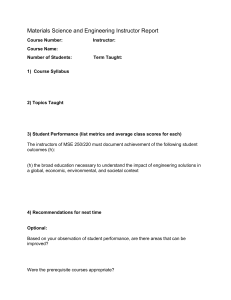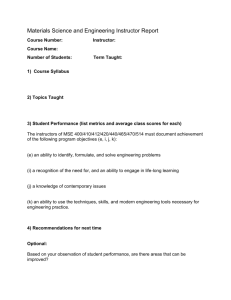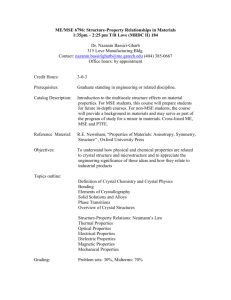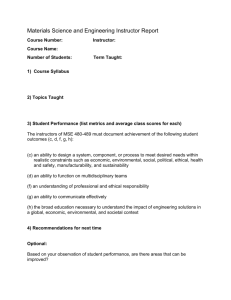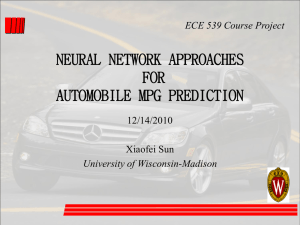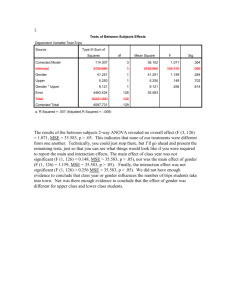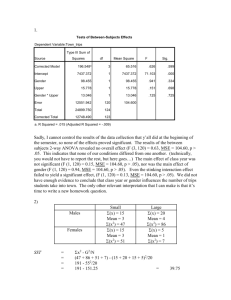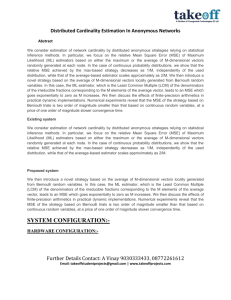University Materials Council (UMC)
advertisement
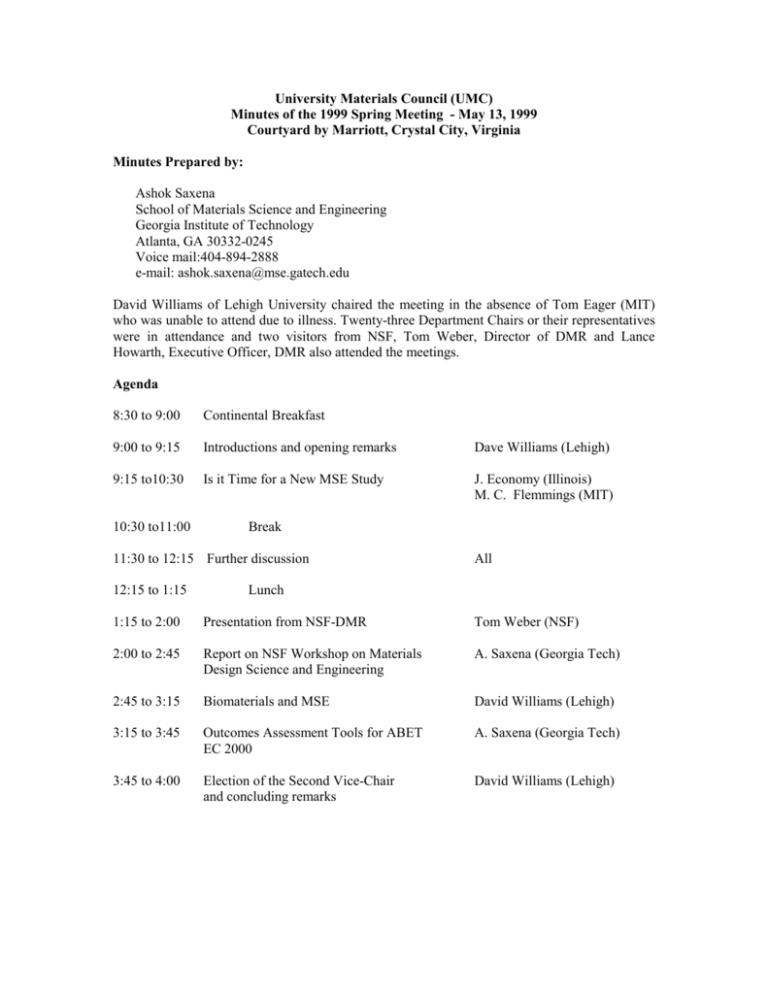
University Materials Council (UMC) Minutes of the 1999 Spring Meeting - May 13, 1999 Courtyard by Marriott, Crystal City, Virginia Minutes Prepared by: Ashok Saxena School of Materials Science and Engineering Georgia Institute of Technology Atlanta, GA 30332-0245 Voice mail:404-894-2888 e-mail: ashok.saxena@mse.gatech.edu David Williams of Lehigh University chaired the meeting in the absence of Tom Eager (MIT) who was unable to attend due to illness. Twenty-three Department Chairs or their representatives were in attendance and two visitors from NSF, Tom Weber, Director of DMR and Lance Howarth, Executive Officer, DMR also attended the meetings. Agenda 8:30 to 9:00 Continental Breakfast 9:00 to 9:15 Introductions and opening remarks Dave Williams (Lehigh) 9:15 to10:30 Is it Time for a New MSE Study J. Economy (Illinois) M. C. Flemmings (MIT) 10:30 to11:00 Break 11:30 to 12:15 Further discussion 12:15 to 1:15 All Lunch 1:15 to 2:00 Presentation from NSF-DMR Tom Weber (NSF) 2:00 to 2:45 Report on NSF Workshop on Materials Design Science and Engineering A. Saxena (Georgia Tech) 2:45 to 3:15 Biomaterials and MSE David Williams (Lehigh) 3:15 to 3:45 Outcomes Assessment Tools for ABET EC 2000 A. Saxena (Georgia Tech) 3:45 to 4:00 Election of the Second Vice-Chair and concluding remarks David Williams (Lehigh) Summary of Discussions and Presentations Is Time for a New MSE Study ? This discussion was included in the agenda at Jim Economy’s suggestion who had been in touch with several members of the Materials Division of NAE where preliminary discussions had taken place about the merit of a new MSE study. The rationale for a new study is as follows: - 10-12 years have passed since the last study spearheaded by NRC. The impact of this study which was very significant immediately following the publication of the report, has diminished considerably with passage of time. - It is perceived that the MSE discipline has experienced significant changes during the last decade and the enrollments in the MSE undergraduate and graduate programs are down considerably form 5 years ago. - Two other recent materials related studies were conducted with somewhat limited scope and an MSE study, led by UMC, is needed to complement the other two. The first of the two studies was sponsored by NSF and dealt with Condensed Matter Physics and the role of “Materials Science”, and the other sponsored by NMAB was entitled “ Forging Links to Users”. Neither of these studies had within their scope, the charter to highlight the role of MSE discipline. It is, therefore, worthwhile to initiate another study. Comments were made that the earlier study took several years to complete and in order to have maximum impact, this one should be completed within a year. Several members supported the idea of a UMC led study and the discussion then focussed around defining a scope for such a study. The main points made by Mert Flemmings and Jim Economy in regard to what the study should focus on are briefly described below. Mert Flemmings: Mert made the point that we (MSE Discipline) do not “own” materials science or materials engineering and that we need to “earn” our place within this broad discipline. Our strength is that we formulate and deliver a broad materials education at both UG and Graduate levels across materials classes, without special biases to other disciplines. A path forward should be: (1) the MSE we practice should be viewed as a discipline operating within the larger multidiscipline of materials science and engineering. The advantage of this approach will be freeing the faculty and students from conceptual and pedagogical restraints imposed by viewing our field as an assemblage of materials classes. (2) Our discipline is that defined by the tetrahedron on structure –processing- property- performance relations of materials, with necessary engineering science at one end of the spectrum, and engineering practice and societal impact at the other end. He advocated the following goals for the new study: • • • Help MSE departments define directions for the rapidly changing environment Improve visibility of departments on campus in eyes of students and administration Increase funding from government, industry and university sources Possible routes for conducting the study could be (a) under the direction of NRC (b)sponsored and governed by UMC with NSF funding and university resources or (c) sponsored by UMC, governed by a university-industry Board (selected by UMC), with funding from NSF, industry and universities. Jim Economy: Besides presenting the rationale for a new study already mentioned above, Jim also proposed the following goals for the new study: • • • Progress in Undergraduate and Graduate MSE Curricula New degree directions, distance learning, relationship to programs in other departments, etc. Role of MSE as an Enabling Technology Existing and new areas of opportunity, sharp drop in the competitiveness of most segments of US industry, role of research universities, National Labs in commercialization of new technology Other themes Enumeration of materials related road maps, Case studies illustrating successful developments, Role of materials as an economic engine Actions Resulting from the Above Discussions: Much discussion between the attendees followed these presentations. There seemed to be broad support for a UMC led study or studies. It was decided to get things rolling, we should split the scope into two studies; one to focus on the academic and education issues and the other on research issues. There was also discussion on eventually merging the outcomes of the two studies, if desirable. For further sharpening the focus of the two studies and defining an action plan, two task-groups of volunteers were formed. These are, 1. Task-Group on Academic Issues: David Williams (Chair), Raj Bordia, Aris Christou, John Rabolt, Tom Devine and Takeshi Egami, Don Paul 2. Task-Group on Research Issues: Ashok Saxena (Chair), Albert Yee, Jim Economy, Reza Abbaschian and Bob Schneider These Task Groups are to meet and hash out issues before the fall meeting in Cincinnati and put together a program for the meeting for further discussion on these topics. NSF Presentation by Tom Weber: Tom discussed the latest organization of DMR and announced that Lance Howarth is the new permanent Executive Officer for DMR replacing Adrian DeGraff who has moved up to the same position at the MPS Directorate level. He discussed funding trends and made a compelling argument for targeting White House for any lobbying efforts as opposed to congressional staff because, in order for congress to even consider a new item, it has to first be included in the White House budget. Tom was kind enough to provide a copy of his presentation on power point which is attached to the minutes under the file name umc-nsf.ppt. NSF Workshop on New Directions in Materials Design Science and Engineering (A. Saxena): Ashok presented the objectives and conclusions of a NSF sponsored workshop on Materials Design Science and Engineering held in Atlanta in October 1998. The workshop was organized by David McDowell of Georgia Tech and Troy Story of Morehouse College. The workshop objectives were: • • • • To evaluate the status, strengths and limitations, of predictive capabilities for materials design across various disciplines To identify intersections of disciplines and methods of training/education which might address limitations and expand applicability To identify potential implications of materials design on science and engineering education and research To identify obstacles, challenges and opportunity areas for future focus The workshop topics were divided along the following lines: • • • • Structure-Property Relations at all Length Scales Materials Synthesis and Design Process Design Science and Engineering Multidisciplinary Materials Education A total of 59 participants from 20 institutions, industries and laboratories took part in the discussions. The overall vision of MDS&E, as an outcome from the workshop, can be summarized as; “ Develop a robust, rapid and reliable capability to design materials for functionality with farreaching economic consequences” . The challenges, implications and imperatives of this vision on materials education and research were discussed and the following workshop recommendations were made: • Follow-on workshop topics - Principles and approaches for more quantitative materials design Enhanced modeling and simulations tools Validated, reliable and comprehensive data bases Methods of in-situ characterization and testing A complete workshop report is available at the following web address: www.mse.gatech.edu/cmc/MDS&E/MDS&E.html or it can be accessed by going to www.mse.gatech.edu and then clicking at the Campus Materials Council and the MDS&E Workshop. Biomaterials and MSE (David Williams): Dave led the discussion on how MSE departments could incorporate biomaterials which is widely seen as an emerging discipline in the MSE curricula. Just as in other fields of materials, the MSE role is not well defined and there are competing initiatives from ChEs and the newly created departments of Biomedical Engineering that have emerged in several universities with funding from the Whitaker Foundation. The discussion focussed around what is biomaterials and what is its scope and how traditional MSE departments fit in the picture. There was no clear consensus on this topic. University of Florida already has a credible program in the area and several other departments are advertising for faculty in the area. This is clearly an opportunity area and one that should be included as a discussion topic in future UMC meetings. Assessment, Accreditation, and Accountability: Beyond ABET; (A.Saxena): Ashok presented program outcomes assessment tools used at Georgia Tech. He particularly emphasized the role of benchmarking with peer institutions, and exit surveys and interviews as assessment tools. For more information, visit the website www.mse.gatech.edu. Business Meeting (David Williams): - David sought opinions from the group about the need for running a separate UMC meeting in conjunction with the MRS meeting in Boston. Tom Eager had been conducting a dinner meeting of UMC in conjunction with the Fall meeting of MRS for the past few years. After some discussion, it was decided that there will only be two UMC meetings in the upcoming year, one during Spring in Washington, D.C. area and the other in conjunction with TMS and ASM meetings in the Fall. The next meeting will be Cincinnati, Ohio on October 31, 1999. - David also conducted elections for the 2nd Vice-chair of UMC for the 1999-2000 year. As per UMC bylaws, the Chair serves a one year term and is succeeded by the 1st Vice-chair and the 2nd Vice-chair becomes the 1st Vice-chair. Professor Kathy Farber of Northwestern was nominated and elected to be the next 2nd Vice-chair. The executive officers of UMC for the next year are then: - David Williams (Lehigh), Chair Ashok Saxena (Georgia Tech), 1st Vice-chair Kathy Farber, (Northwestern), 2nd Vice-chair Tom Eager (MIT), Reza Abbaschian (Florida), Jim Economy (Illinois) and Richard Tressler (Penn State), are Members-at-large The meeting adjourned at 4:00 PM.
